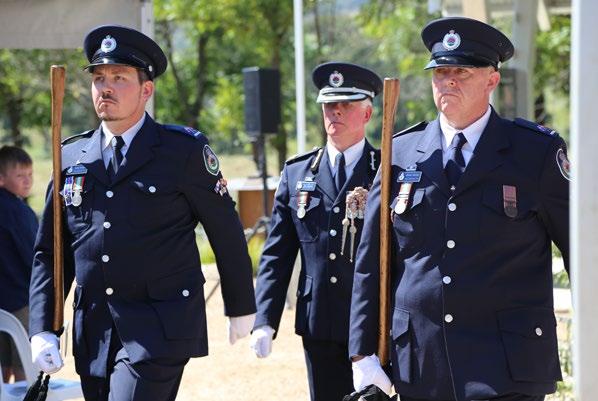
5 minute read
Technicians take to the air to restore site on Far North Coast
With roads inaccessible during flooding events on the Far North Coast in March 2022, NSW RFS officers got off to a flying start on a multi-agency response to fix electrical faults.
During major incidents, Far North Coast District Manager Superintendent David Cook would typically work from the Fire Control Centre in Murwillumbah.
On 27 February however, the FCC was inaccessible, the satellite office in Mullumbimby was inundated and inoperational, and Superintendent Cook’s home was surrounded by floodwater. He was left with no choice but to work remotely.
On the morning of 28 February, communities of the Northern Rivers were reeling from the flooding event the night before. Meanwhile, Superintendent Cook was struggling to get an SMS out.
“Internet, NBN and phone services just collapsed over the whole of the northeast part of the state, including the Northern Rivers and Clarence Valley,” Superintendent Cook recalls. “We’ve been through it before, but we didn’t expect to lose communication.
“We were relying on the NSW RFS Private Mobile Radio (PMR) network to give us connectivity to all our brigades and the SES. However there were also significant complications with the PMR network.”
From NSW RFS HQ, ICT Engineering Field Supervisor Graeme Smart had a full picture of the disturbances being caused by the unfolding flood crisis.
“On the top of Mount Nardi are all the major telephone carriers, the ABC, local FM radios stations and other TV stations,” says Graeme. “It’s a critical site for the NSW RFS Far North Coast and Northern Rivers radio networks, NSW Police, NSW Ambulance and others. For Essential Energy, it is the site which connects their control room to the electrical grid on the North Coast.
“The loss of that site would have provided significant operational impact to several agencies, and resolving this was one of the major bodies of work we undertook during the floods.”
RFS ICT Field Operations Officer, Bryan Davison, had been mainly working in the Incident Management Team at Casino when he received a call at his home on Thursday night.
“It was after-hours, my boss rang me and said we’ve just had a significant alarm to Mount Nardi,” says Bryan. “Already, the grid power had failed at the height of the storm activity. As a result, multiple emergency services were being powered through a generator backed up with batteries. However, the generator had run out of fuel and when the batteries went flat, the PMR network was broken into two.”
Landslides and broken power lines in the valleys surrounding Mount Nardi made the site physically inaccesible for crews to get to by road, with blockages at numerous points on the main access track.
“Flooding makes my job more difficult – if something breaks, how do we get there? It has to be by helicopter,” says Bryan.

The generator is lifted to be taken to Mount Nardi
Photo by Bryan Davison.
A SHARED MISSION
From the State Operations Centre, NSW RFS ICT staff Fil Mincev, Matthew White, Ben Beath and Graeme Smart co-managed a multi-agency response to get the site back online alongside the NSW TELCO Authority (NSWTA).
“An initial helicopter flight was coordinated to Mount Nardi with a dual purpose: to attempt to land, drop off the RFS ICT Field Operations Officer and the NSWTA technician, and check over all of the agencies’ radio equipment – but it was impossible for the helicopter to land,” says Bryan.
“So we had to get a helicopter back to site to winch in the NSWTA technician to prepare the site, then a generator was long-lined in. Once the multi-agency radio equipment was connected to the generator, the technician was winched back out.”
At the same time, Bryan was working with David from Far North Coast to start migrating the district operations across to the newly completed Public Safety Network (PSN), formerly known as the GRN, to ensure that operations could continue if it wasn’t possible to get the generator up to Mount Nardi.
A SHINING EXAMPLE OF MULTI-AGENCY COOPERATION
The switch from the PMR network to the PSN was a success, allowing the District to communicate normally.
“There was a short education process which the District managed very well under David’s control,” says Bryan. “To move from one radio network to another may seem simple (like changing the channel on a TV), but it’s not so straightforward – the brigades did a fantastic job.”
For Graeme Smart, the multi-layered undertaking demonstrated how effectively the NSW RFS is able to work under time pressure alongside other agencies.
“The operation to deliver the generator to the site was a shining example of multi-agency cooperation. Together we made sure that the NSW RFS and other key services could continue communicating.”
Far North Coast District Manager Superintendent David Cook views the collaboration as a credit to those working behind the scenes in the Service.
“Once we switched to the PSN, it worked fantastically,” says David. “It allowed us to communicate and showed we have the capability to switch when the systems fail.”






